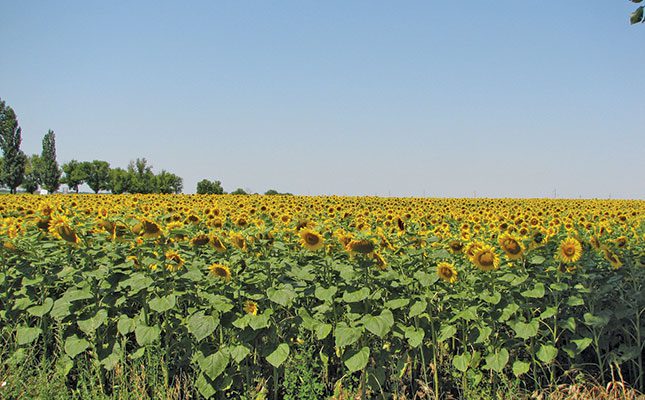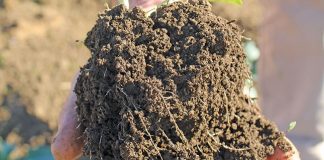
Photo: Wikimedia Commons
In this article, we look at diseases that can affect sunflower crops in South Africa. While some are more common than others, all those listed here can cause severe yield and economic losses.
Foliar diseases of sunflower are caused by various pathogens, including Alternaria helianthi, Puccinia helianthi and Septoria helianthi. They cause various symptoms on foliage, which may result in lower sunflower yields during seasons that are favourable to their development.
The ideal environmental conditions for the development of these diseases vary, and so correct disease identification is crucial for developing appropriate disease-management strategies for each.
Alternaria leaf spot
Alternaria leaf spot is a major defoliating fungus that occurs in warm, humid climates all around the world, according to the Agricultural Research Council (ARC). There are many species that cause leaf spot, but A. helianthi is the most common. A. helianthi overwinters on infected plant residue, the ARC explains, but wild sunflowers can also be reservoirs. A. helianthi seeds are also wind-borne.
The optimal temperature for the germination of the fungus is above 26°C, and at least four hours of wetness are required. Seedlings are the most prone to infection.
What to look for
Alternaria causes linear spots on the stem of the plant, as well as sunken, water-soaked lesions on the back of the head, says the ARC.
However, the council warns that all Alternaria species cause similar symptoms, making it difficult to identify the particular species in-field.
Sunflowers infected with Alternaria may present with lesions on the leaves, stems, petioles and bracts.
The lesions may be small, dark and angular at first, but as the disease progresses, the spots coalesce into large, necrotic areas that cause defoliation.
The ARC says: “Defoliation starts with the lower leaves. Stem lesions [are] typically narrow (1mm to 3mm) black streaks of up to 3cm long.”
Control and prevention
The following steps can be taken to prevent the spread of Alternaria leaf spot:
– Remove wild or volunteer sunflowers;
– Remove or incorporate previous sunflower residue into the soil;
– Minimise extended leaf wetness; and
– Use appropriate, registered fungicides.
Downy mildew
Downy mildew is somewhat uncommon in South Africa, but is still an important disease of sunflower. It is caused by the soil-borne fungal pathogen Plasmopara halstedii. It can result in yield losses, the severity of which is determined by the percentage of infected plants and their distribution within the field, according to the ARC.
P. halstedii can survive for up to 10 years in contaminated soil as oospores, and volunteer sunflowers can serve as alternate hosts.
What to look for
The ARC says that early infected plants usually die, causing a reduction in plant stand that leads to bare patches in the field.
“Systemically infected sunflower plants are usually dwarfed or stunted, with shortened internodes and the sunflower head pointing straight upward,” it adds.
The surviving plants present with a thickening and yellowing of the leaves, which usually borders the veins thereof.
However, these symptoms can also be present across the entire leaf.
White mycelium and spores are present on the undersides of the leaves.
Control and prevention
The following steps can be taken to prevent the spread of downy mildew:
– Plant resistant hybrids in areas where downy mildew is a problem;
– Remove volunteer sunflowers;
– Use appropriate and registered fungicides; and
– Plant resistant cultivars.
Head and stalk rot
Sclerotinia head and stalk rot are caused by the fungus Sclerotinia sclerotiorum. Other than sunflower, it infects soya bean and canola, among other crops. The fungus can survive for four to seven years in the soil and plant debris as sclerotia (a compact mass of hardened fungal mycelium).
Infection occurs during the flowering stage, when the temperature is cool and there is a high level of rainfall, says the ARC. Wounds on the back of the sunflower heads may become sources of infection that initiate head rot.
According to the council, Sclerotinia stem rot of sunflower is not a direct major threat to sunflower production in South Africa.
However, Sclerotinia head rot can cause major damage.
Head rot is limited to major sunflower production regions in South Africa (Limpopo, North West, Mpumalanga and the Free State), according to the ARC, but can also occur in other provinces where the crop is grown.
What to look for
In terms of head rot, the back of the sunflower head becomes soft, light-brown in colour and spongy as the disease progresses.
“This infection extends into the developing head and down the stalk, and eventually only the fibrous strands at the back of the head and upper stalk remain,” says the ARC.
The infected seeds at the front of the head eventually fall due to their weight. “Large, black sclerotia (small, black, bird-dropping-like particles) develop below the seed layer and around the seeds,” it explains.
With stem rot, initial symptoms include the plant suddenly wilting, particularly during grain fill. The base of the plant may also become brown and water-soaked.
“The sunflower stem pith is a white, cotton-like tissue, which includes mycelial growth in which large, black sclerotia form. Sclerotia can sometimes be seen on the outside of the stalks of sunflower plants when they get older.”
The stem will often break at this point due to the infection, and when ripped open, black sclerotia can be seen. Due to a lack of nutrients and water not being taken up properly, heads don’t fill properly.
Control and prevention
The following steps can be taken to prevent the spread of sclerotinia head and stalk rot:
– Avoid planting sunflowers on infested lands for a period of five to eight years;
– Practise crop rotation;
– Plant resistant cultivars; and
– Treat seed with the fungicide Benomyl.
Brown rust
Brown rust is caused by the fungus P. helianthi Schw. It can cause great yield losses, and severe infection can cause a decrease in head and seed size, as well as oil content.
Rust overwinters as teliospores on plant debris, as well as on volunteer sunflower plants, and doesn’t require alternate hosts, says the ARC. Urediniospores are spread by the wind, and can infect stems, bracts, petioles and leaves.
Rust prefers warm temperatures and moisture in the form of rain or irrigation. According to the ARC, in dry years, dew formation on leaves may lead to infection.
“High nitrogen fertilisation and seeding rates result in excessive foliage, which increases humidity within the canopy, and this favours rust development,” explains the ARC.
What to look for
Infected plants present with cinnamon-coloured spots or uredial pustules, which mainly occur on the leaves, stems, petioles, bracts and the back of the head. The pustules on the undersides of the leaves turn black, says the ARC. “The [tops] of the leaves show aecial pustules, either alone or in clusters.”
Control and prevention
The following steps can be taken to prevent the spread of brown rust:
– Plant resistant hybrids;
– Practise crop rotation;
– Reduce irrigation and the application of nitrogen fertiliser if possible; and
– Apply registered fungicides.
Septoria leaf spot
Septoria leaf spot in sunflowers is caused by the fungus S. helianthi. The fungus is seed-borne and can survive on infected sunflower crop residue, says the ARC.
It prefers moderately high temperatures and moisture, and can occur throughout the growing season.
What to look for
The ARC explains that Septoria leaf spot initially develops on the lower leaves of the plant, before spreading to the upper leaves.
“The spots begin as water-soaked areas, which are angular with tan-coloured centres and brown margins. A narrow yellow halo often surrounds young spots.
“However, mature leaf spots may contain tiny black specks, [which are] the fungal fruiting bodies [known as pycnidia].”
The pycnidia distinguish Septoria leaf spot from Alternaria leaf spot.
“Severe infections can cause defoliation, but if this affects only the lower leaves on mature plants, the impact on yield may be minimal,” explains the ARC.
Control and prevention
The following steps can be taken to prevent the spread of septoria leaf spot:
– Practise crop rotation;
– Destroy debris and bury residue;
– Plant resistant varieties; and
– Use the correct plant spacing.
Sources: ‘Alternaria Leaf Spot and Blight (Alternaria spp.)’; ‘Downy mildew of sunflower: Uncommon, but can cause localised damage’; ‘Sclerotinia disease of sunflower: A devastating pathogen’; ‘Brown rust of sunflower: A scarce, but potentially damaging disease’,











